With our 2800+ mile Atlantic long passage sailing expedition fresh in my mind, let me list the items that made a difference to the journey. Some items made life easier, others made the trip more comfortable and many helped make the 18-day adventure more fun.
Spending days at sea can be an excellent experience but like anything, it has its ups and downs.
On Britican, we crossed the ocean in November/December with a crew of six adults and a five-year-old. The trip was mostly uneventful – every day we had similar winds, a constant back and forth swell, the sail configuration rarely changed and our view of 360 degrees of blue remained constant.
Before embarking on our 18-day transatlantic crossing, we spent a month servicing the boat, provisioning food/water and psychologically preparing ourselves for an adventure of a lifetime. There are many great articles and even books out there to provide solid advice for long passage sailing, but what I thought you’d find interesting are the items or things that stood out – the non-essentials.
So here’s my list of non-essentials that are over and above making sure that the boat and it’s inhabitants are ready for the journey…
12 Non-Essentials for Long Passage Sailing
1. Non-skid mats
These are actually essential for all sailors whether you’re doing day trips or long sails. I felt the need to include them under non-essential, however, because I’ve met several boaters that don’t have them. Our lives would have been miserable if we didn’t have our non-skid mats strategically placed all around the boat. The mats are featured in the picture below – we have blue and black mats but they come in a variety of colors. These are a must for short and long passage sailing!
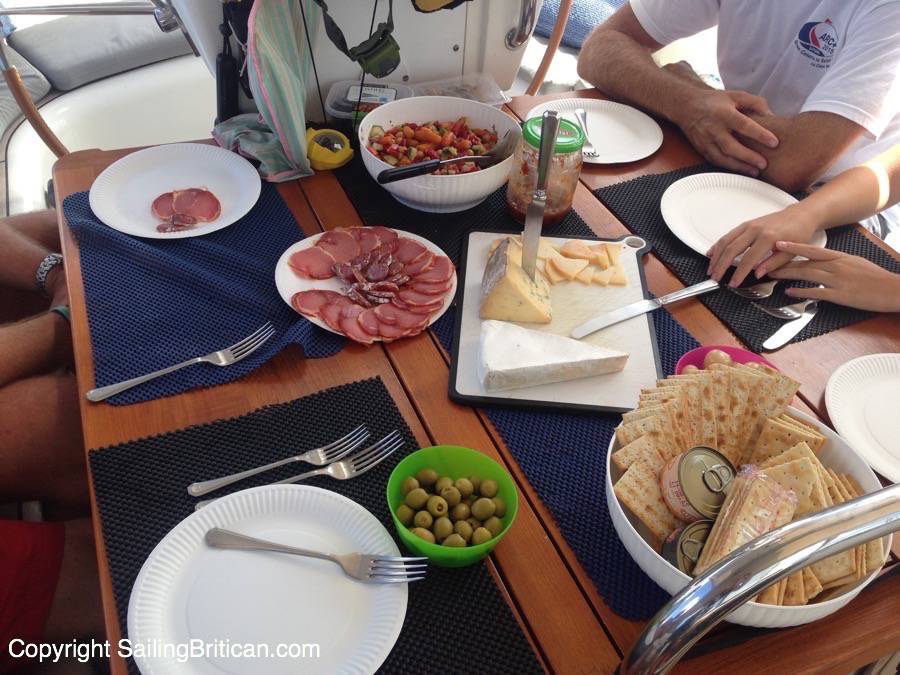
Every day for 24-hours a day the boat went up and down with the waves and side to side with the swell. For 18 days there wasn’t one moment where we weren’t rocking, quite drastically at times, from side to side.
During meal preparation, the mats were absolutely necessary! We’d get out the ingredients, place them on the mat, grab the cutting board, and place it on the mat, and so forth. Without the mats every five seconds everything would be rolling around the counter and falling to the floor.
Aside from meal preparation, the mats were a godsend for mealtimes. Whether we ate in the cockpit or down in the saloon the mats were necessary. Without them, everyone would have had to hold their bowl or plate and perhaps waited to drink anything after a hand was free.
I also put the mats in all the cupboards to prevent cans and jars from rolling…and strategically left mats on all flat surfaces to prevent sunglasses, books, and other odds and sods from smashing to the floor.
2. Large plastic bowls
Before we left Las Palmas I found an inexpensive housewares shop. After looking around for a while I settled on six dog-bowl sized plastic bowls for long passage sailing.
After living through storms and doing bumpy night sails I knew first hand that a normal size bowl doesn’t work very well. Whether you’re eating soup, stew or casseroles, the contents of the bowl slop all over the place. If you get a full portion in a normal bowl the chances of spills and potential burns are high.
My objective with the dog bowl was to allow a full-sized portion of the room to slosh about with ease. It worked perfectly! In the picture below, I included a standard-sized Ikea bowl so you could appreciate how large the bowls were that I purchased.
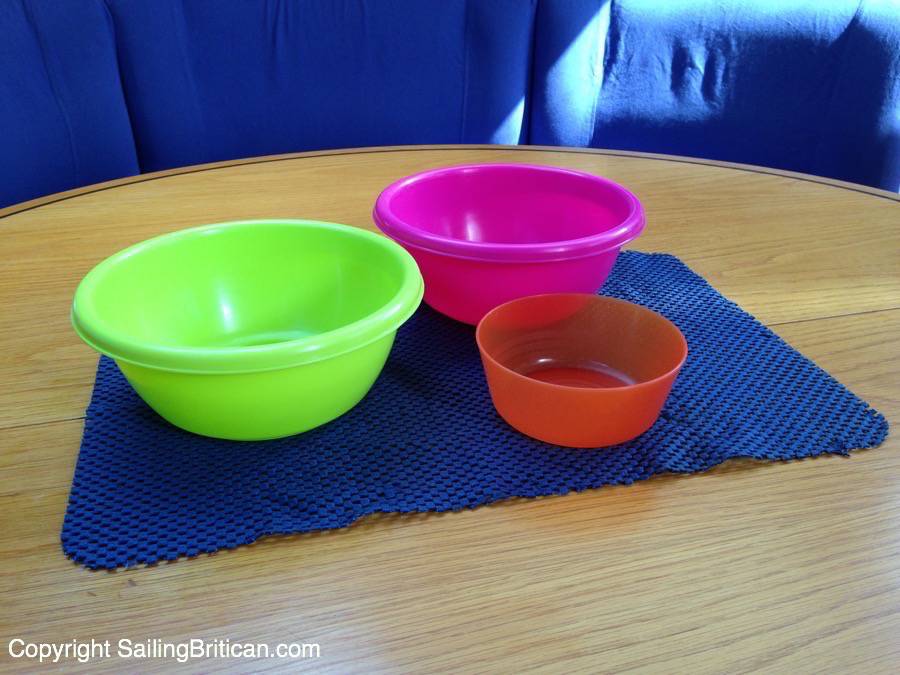
Furthermore, during our third day of crossing our bowl cupboard accidentally opened up and all the bowls went flying to the floor and across the saloon. Our normal bowls smashed to pieces but thankfully our dog-bowls survived.
3. Laxatives
For some reason, most of us had constipation issues at one point or another during our long passage sailing trip. I can understand guests having issues as it’s a new environment but I found it interesting that many of our seasoned crew also got a bit plugged up.
Perhaps it’s a change in diet that caused our issues? I thought we were eating way better than we normally did but something caused a stop in a regular flow.
Needless to say, it became quite a topic of discussion. To ease discomfort and reduce the need for that kind of dialogue make sure to have a pack of laxatives on hand in your heads.
4. Journey related games, competitions and parties
Every day throughout the crossing we all entered a guess for our distance traveled in 24 hours. Around 1 pm boat, or UTC, time we’d do the calculations and discover who came the closest. We also kept a runny tally. By the end of the trip, I was over 100 miles out yet the winner was around 25 miles out. Everyone looked forward to the readout and we spent at least an hour a day discussing the competition. The distance traveled was just one of our games…
Before leaving the jetty in Las Palmas, I notified all the crew that prizes would be awarded in St Lucia for:
- Largest fish caught
- Silliest comment made
- The best score for guess our distance in 24 hours
- Best meal
- Best young sailor (an award set for our daughter to win)
- The person who slept the most
During the long passage sailing trip, we discussed these awards time and time again. Someone would say or do something silly and we’d mention that they were in the lead for the ‘Silliest Comment’ award or whoever caught the most recent fish would be eager to measure the length.

Our crewmember, Eve, won the silliest comment. During a night watch she gazed up into the sky and yelled out, ‘Wow – look up, there’s a green star!’ Of course, she was quickly laughed at and told that the green star was indeed the starboard green navigation light at the top of the mast. Poor Eve will never live that comment down.
Incidentally, Eve also won the award for sleeping the most.
Another crewmember, Murray, won the best meal. He delighted our taste buds with pork fillet stuffed with apricots, roasted potatoes, and lovely cauliflower cheese. Thinking back on it now, that meal was one of the best meals I’ve ever had. We were in the middle of the Atlantic enjoying a roast dinner – it was bliss.
Our daughter, Sienna, won the best young sailor award and she was delighted with her award, a miniature trophy.
Aside from competitions, we also had two schedule parties and one spontaneous event. We planned for Thanksgiving (American) so there was a meal of turkey, cranberries, mashed potatoes, green bean casserole, stuffing, and gravy. Thanksgiving dinner pictured below.
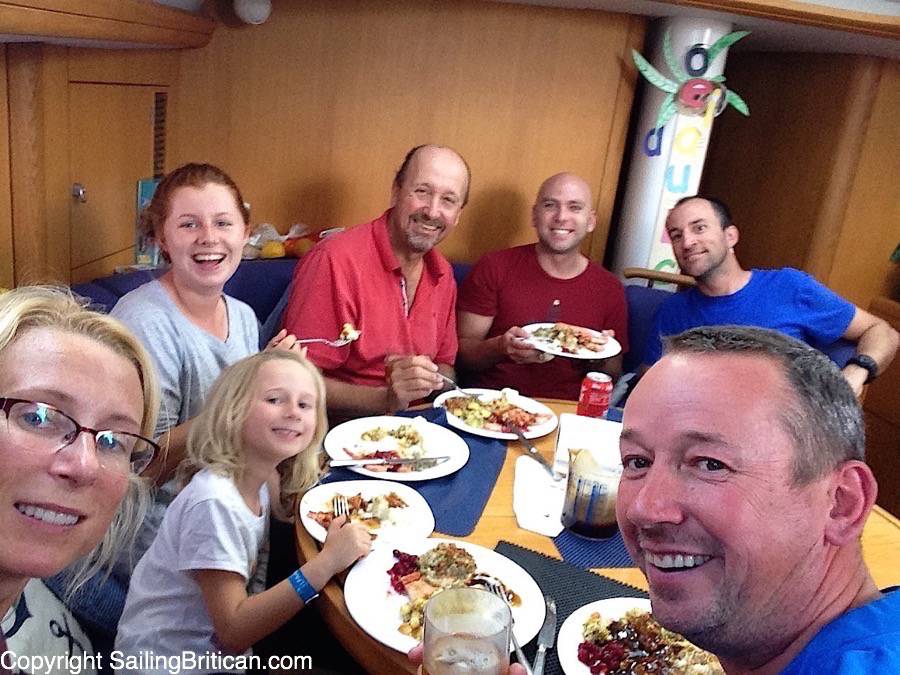
My daughter, Eve, and I made a turkey from colored paper and a paper towel roll. We cut out feathers and asked everyone to write down what they were thankful for. Once we had all the feathers we assembled the turkey!
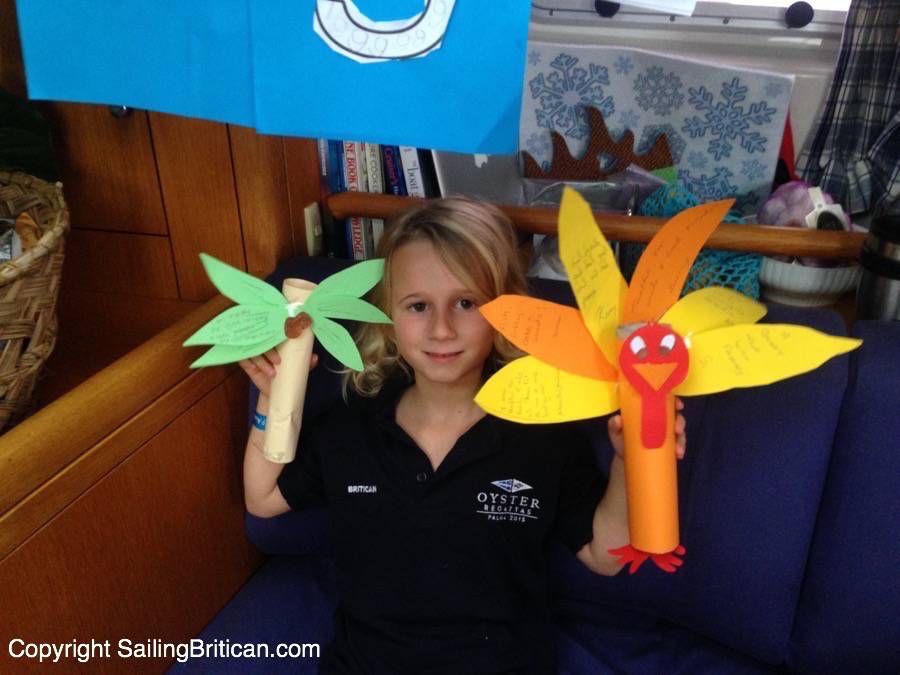
The other planned party was the ‘Half Way Across the Atlantic Party!’ Previous to our departure, our daughter, Sienna, and my husband went to a party store and purchased pirate paper plates, cups, balloons, streamers, and a pirate hat. We asked everyone to choose some food or drink to enjoy at the party.
When the party day came, we all decorated and put our contributions onto the middle of the table.
There was pate, Spanish jamon (cured ham), fruitcake from England, Canary Island cookies, Aloe Vera drinks, special beers and we also had some fresh Tuna Sashimi.
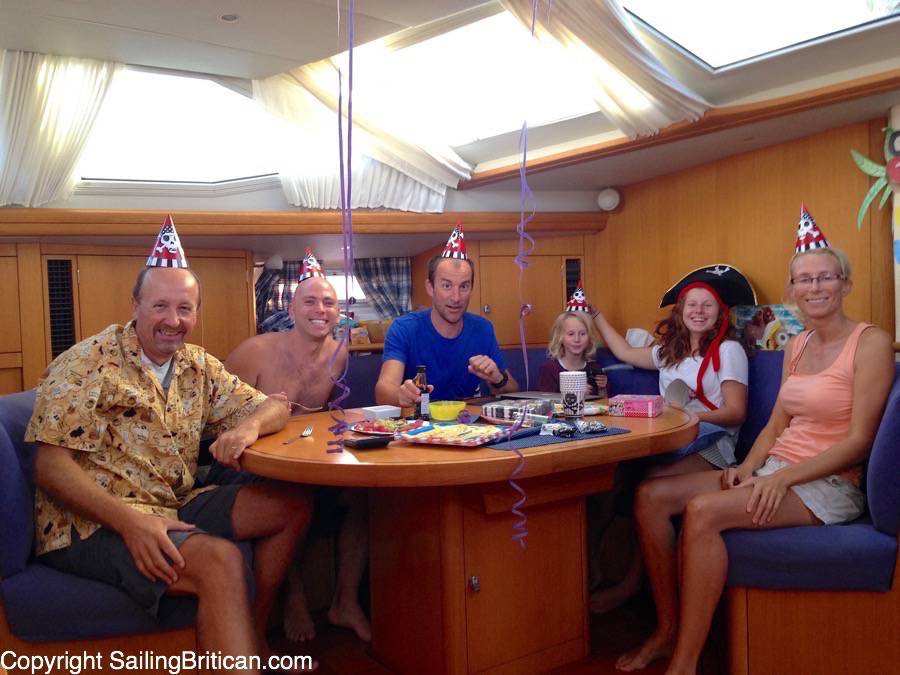
Everyone enjoyed the party.
Towards the end of the long passage sailing trip, when we all started getting a bit bored, I put a bunch of our daughter’s craft supplies on the saloon table. I announced to the crew that at 5 pm we’d be having a ‘Hat Party’ judging ceremony. Everyone had to make a hat and a prize will be awarded for the best hat.
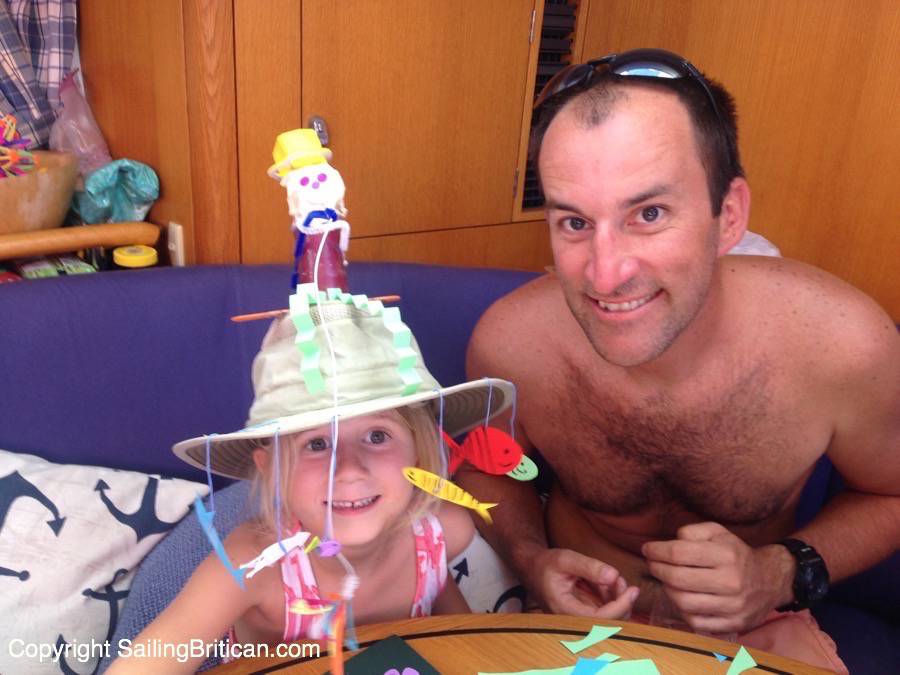
The whole day was filled with laughter. Everyone took their time and enjoyed the task. By 5 pm, when we all assembled in the cockpit there were loads of laughs. To determine the best hat we all wrote our selection on a piece of paper and awarded the person with the most votes with the prize.
Our crewmember, Kenny, won hands down. The hat is pictured above on Sienna. Kenny’s fisherman fishing was an outstanding contribution to the hat party.
5. List of duties and watches for long passage sailing
I’ve never known of a boat that travels through the night that doesn’t have a night watch schedule. Usually, someone is on deck from 8 pm until 11 pm and then someone else takes over at 11 pm and on the schedule goes. Some people do three-hour watches and others do longer. If there are enough people, watches might consist of two people on deck for three to four hours at a time.
Some boaters swear by each person keeping the same watch for the duration of the trip, so for example, every night I’d do the 11 pm to 2 pm watch. Others, like us, would rotate through the hour blocks and change every night so that no one was stuck with an undesirable time slot.
The excel sheet pictured below to the left shows the night watches on the top and below are the task lists. The print out on the right shows where all our stopcocks are located in case we have to quickly turn one-off. We kept both printouts on our daughter’s art line for the duration of the long passage sailing journey.
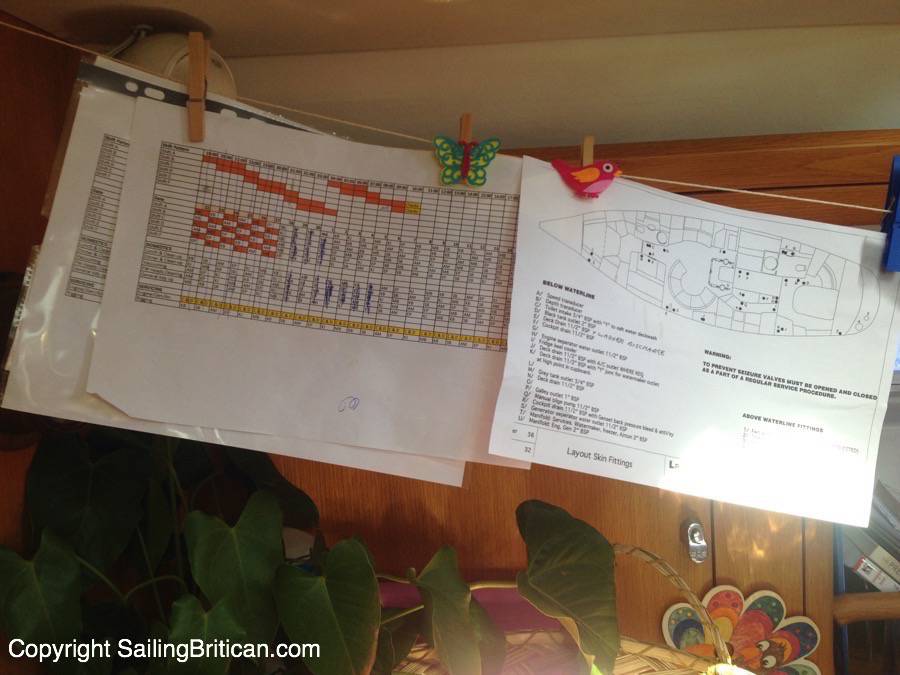
When crossing the Atlantic we made a schedule that allowed everyone to do every shift with every person and then repeated through the schedule. There were never any complaints – all the crewmembers simply looked at the schedule and did their shift.
By having the schedule ready in advance there was no need for discussion – it was just part of the journey.
With cooking, housekeeping, and maintenance I created a schedule right below the night watch schedule so everything was on one sheet of paper. The tasks to be performed every day included:
- Vacuum the whole boat and soft furnishings (sofa and couch)
- Clean the heads
- General pick up including trash/rubbish duty
- Cockpit clean up
- Rigging check
- Engine and generator checks
- Lunch duty and clean up
- Dinner duty and clean up
So, every day each crewmember would look at their duties for the day. I left off breakfast and relied on everyone to get their own grub and clean up after himself or herself. For other meals, people could choose to heat up one of the premade meals, I made and froze in advance, or make a meal of their own.
And when we caught fish, we ate the fish until it was gone.
After catching a tuna we had it for lunch, dinner, and lunch the next day!
The schedule worked so well. On the odd occasion, a couple of crewmembers would switch tasks, or when someone was unwell everyone banded together to replace the ill person. There was no opportunity for slackers as the job had to get done. In the end, the boat was kept tidy, we ate a nice meal every night and the things that needed to be serviced were serviced.
(If you’d like a copy of my excel schedule, email me and I’ll send it to you)
6. Normal games (board, tile, card)
While sailing long distance there are only so many things you can do for entertainment. We often watched movies at night, read books during the day and many of us took long naps.
When a bunch of us were in the cockpit, however, either the Rummikub or deck of cards would come out. Rummikub, a tile game similar to the card game Rummy, was usually our preferred game due to the weight of the tiles.
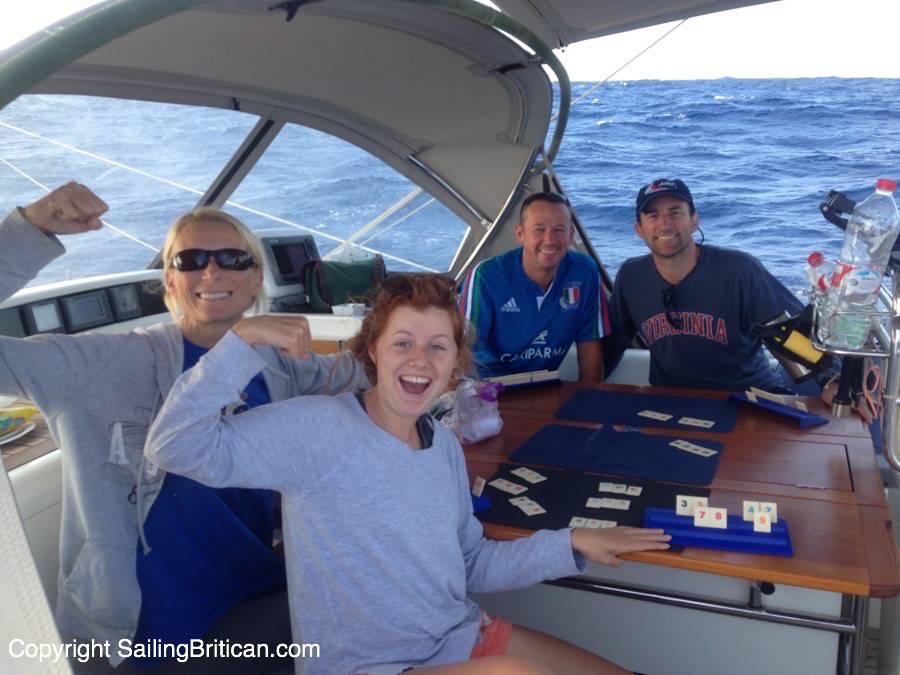
With our sticky mats covering the surface of the table we’d lay out the tiles and play the game without fear of the tiles being blown away. Cards often went flying and board game pieces didn’t like to stay standing!
Whenever we played Rummikub we’d keep a running tally so to award someone a prize at the end of the trip.
Aside from Rummikub we also played cards, chess, and a few question trivia games.
7. Proper fishing gear (Pole, gaff, old towel, fillet knife, cutting board)
If you’re planning on catching fish and you’re not a natural-born fisherperson (like us), there are a few non-essential long passage sailing essential fishing things you need. Aside from the rod and reel with a strong fishing line, I highly suggest a 5’ to 6’ gaff. A gaff is a long pole with a hook on the end used for spearing and lifting the fish when you get it alongside the boat. I took a photo of our gaff in the next picture – it looks small but it’s very sold and long.

When fishing in the Atlantic off a sailboat, the fish are too large for a net, and having a person get down on the sugar scoop (back part of the boat close to the water) to grab a fish is way too dangerous. The risk for man-over-board (MOB) is way too high. With a long gaff, you can safely stay on the boat, reach down and gaff the fish.
Additionally, it’s important to note that filleting a fish is a dirty business.
There’s a massive amount of blood and quite a bit of space is needed. We used the area at the aft or back of the boat for our fish cleaning station. After we caught our fish, we’d quickly end its life while holding the head of the fish in a bucket over an old sheet. Before we put the sheet and bucket down, we’d wash the deck with saltwater. We use that same trick before we put Diesel in our tanks – if you wet the deck with salt water it’s less likely that you’ll get stains.
After the blood drained out of the fish, we’d clean and fillet the fish on deck placing the hunks of fish in an aluminum-roasting tray. Once the fish was in the galley we’d then clean the fish further, perhaps take the skin off, clean, and put in zip lock bags. We dedicated one fillet knife and one cutting board to fish only – if you cut fish on a cutting board they smell of fish will stay with it for weeks!
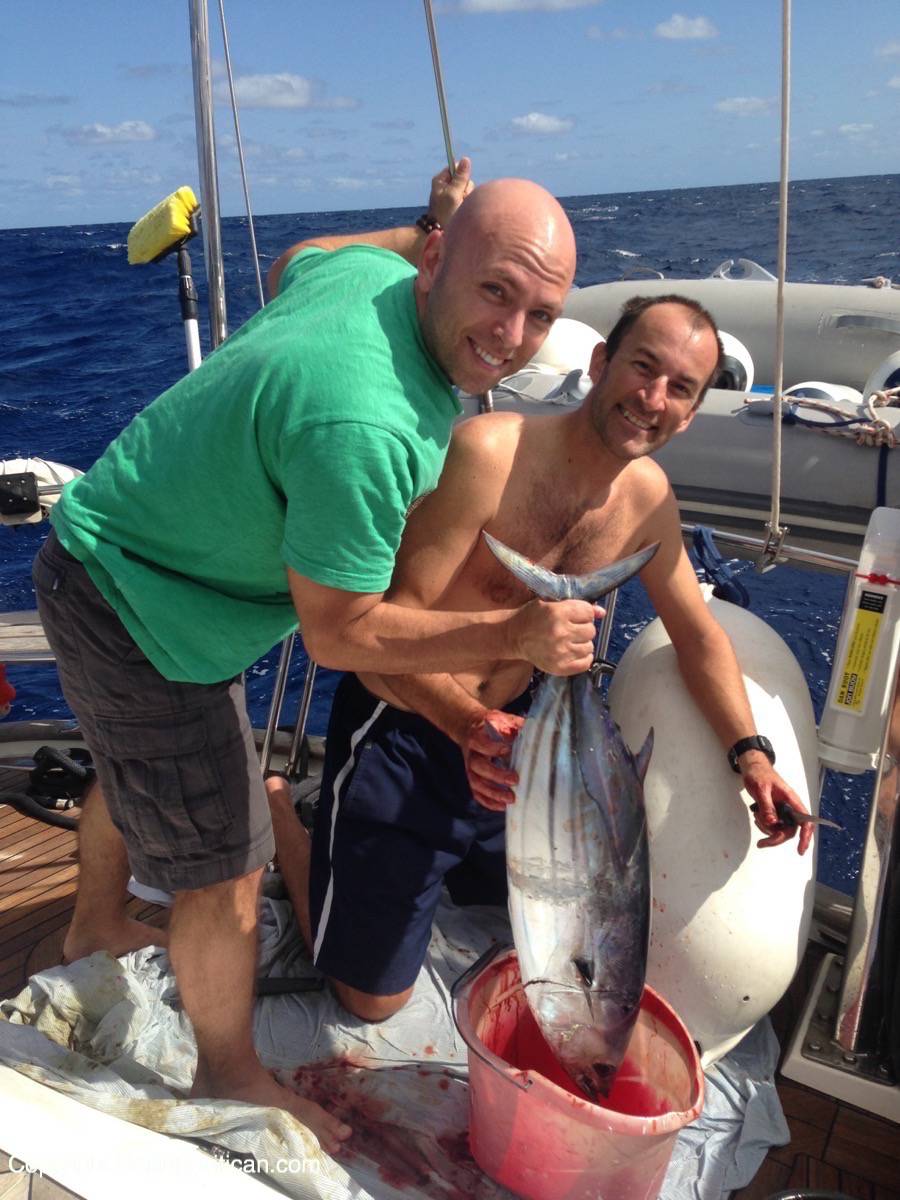
8. New music for long passage sailing
Normal land-based folk has the opportunity of listing to music on a radio, different music from their MP3 player playlists, and background music whenever they enter a restaurant or shop.
When sailing across the Atlantic it takes only a few days to get sick and tired of your own music. We, therefore, asked every crewmember to bring music with them. Most people have music on their phones or iPad so it wasn’t hard for us to have a very eclectic mix of tunes.
Furthermore, we asked every crewmember to pick their ‘boat song’ so that we could play all the boat songs when we felt like a pick-me-up. The overall boat song for Britican is the song ‘Happy,’ by Ferrell Williams and my personal boat song for the Atlantic trip was ‘Riptide’, by Vance Joy.
9. Beanbag
This is a massively non-essential item and my husband was not pleased with my full-sized beanbag purchase…at first. Yes, they do take up space and no they are not practical on a boat, but let me tell you that some of my best Atlantic crossing memories are of me sitting on the bow of the boat, alone, in my beanbag looking out at the flying fish, cloud formations, and from time to time, my dolphin visitors.
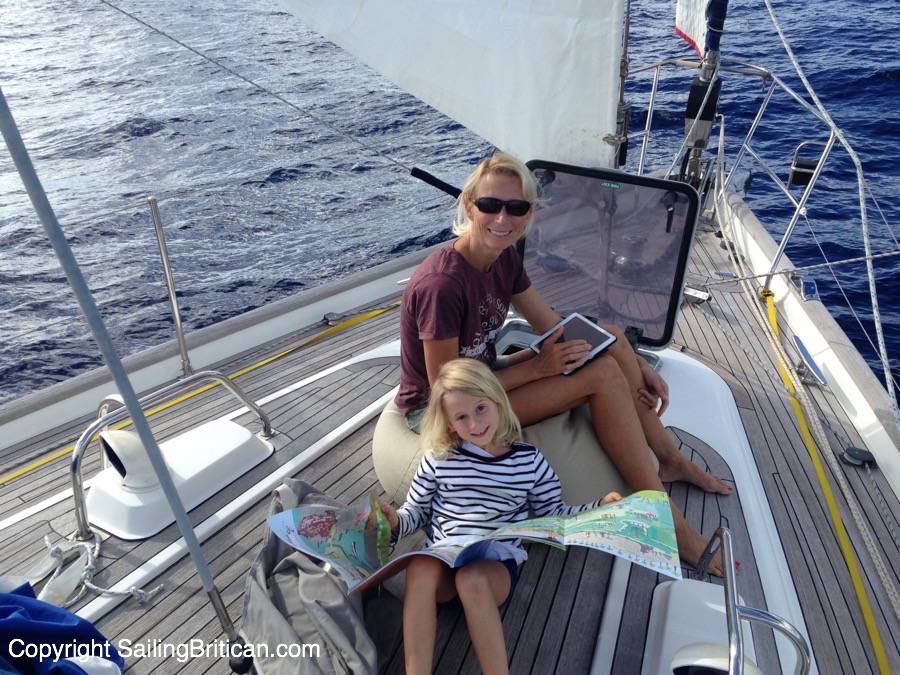
I’d watch the sun come up, the sun goes down and spends as much time as I could soaking up the Atlantic vibe on my contour fitting, comfort inducing lightweight bean bag.
Furthermore, we discovered that the beanbag works great as a headrest on our saloon sofa – two people can put their heads on it and wrap themselves around the sofa in great comfort. Another must-have for long passage sailing.
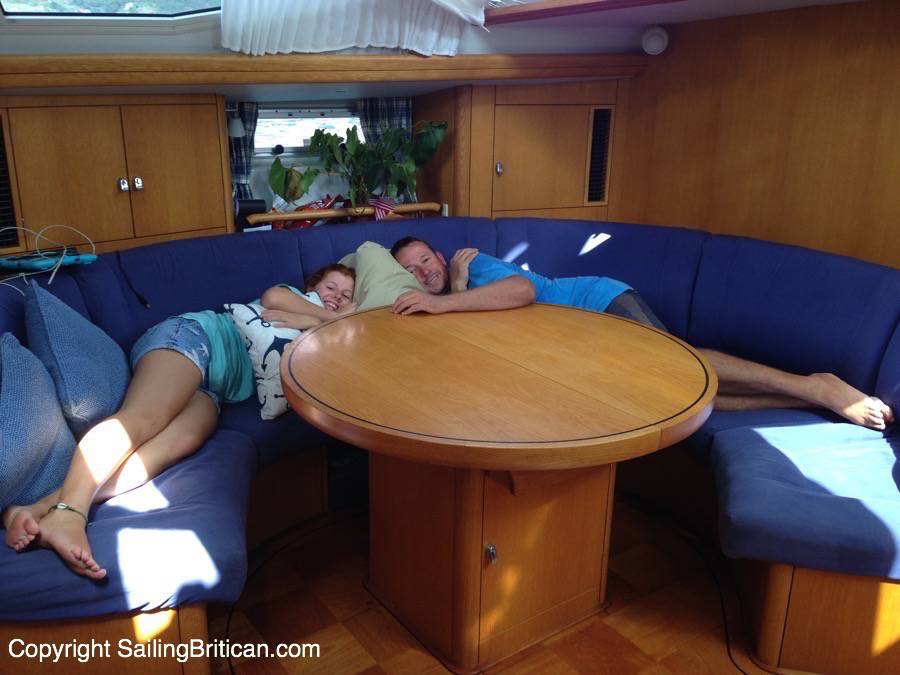
Sure, from time to time it gets in the way, but for the most part, I can tuck it at the bottom of our daughter’s bed and no one even knows it’s there.
10. Laugh minute
We actually didn’t do the laugh minute on our long passage although I thought it was a brilliant idea. Perhaps it was too ‘American’ for our British and New Zealander crewmembers?
Every day at 4 pm I wanted everyone to partake in a laughing contest for one whole minute. A long time ago I read about groups of people, in the States, that all get on a conference call at a set time and laugh with each other for a while. Apparently, the more you laugh the longer you live.
My laugh minute was pooh-poohed but perhaps someone else might give it a go?
11. Group exercise
For our long passage sailing group exercise sessions, I actually pooh-poohed this one. All the guys had a go on some kind of exercise contraption hooked to the back of the boom. They had their five minutes of ego-boosting, chest pumping, exertion groaning fitness workouts.
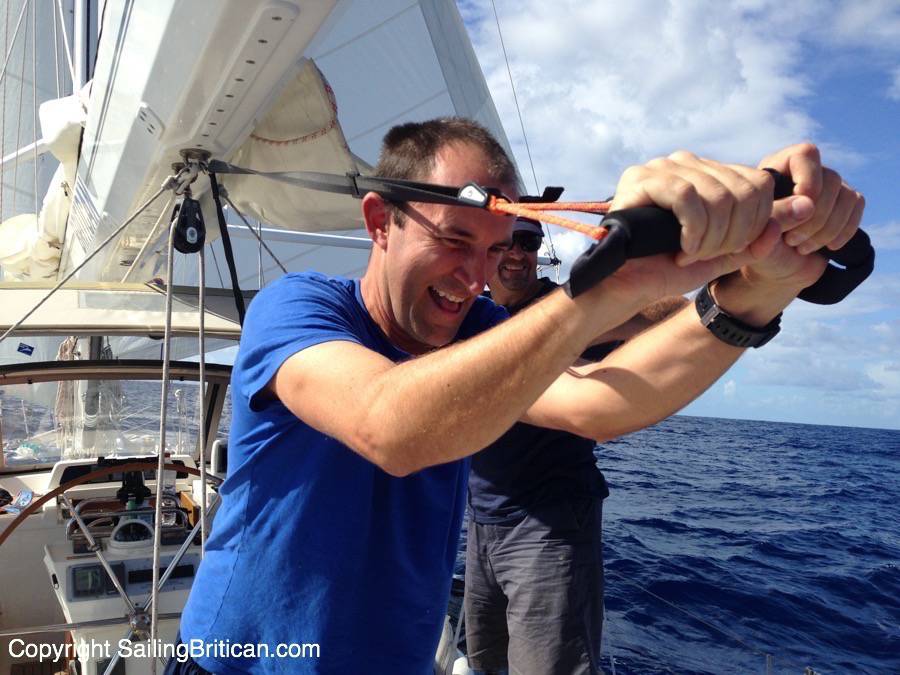
I’m actually surprised that no one injured themselves – they guys were pushing outwards while most of their body weight was forward while on a base that was moving up and down, side to side.
Anyway, it was an activity that kept the boys entertained every other day.
12. Secret stash of sweets for long passage sailing
Hours before we climbed aboard Britican to leave for our Atlantic crossing I made a quick dash to the local minimarket to buy a family pack of Snickers and Twix candy bars.
Throughout the course of a year, I might eat a total of five candy bars so I wasn’t worried about having a secret stash. I just thought that it’s better to have something sweet stored away just in case of emergencies.
That being noted, there were several occasions when I hid in our back cabin, relaxed in bed, and devoured a delicious candy bar. I felt as if I was in heaven biting into the sweet snack.
I suppose that there’s a bit of sensory deprivation while doing long passages. And there are very few guilty pleasure opportunities so a little ten-minute break with a candy bar felt incredible.
And the stash isn’t just for a cheeky little snack break.
Sweets, chocolate, and anything in demand on a boat can be traded for things. Similar to prison, you can trade a Twix bar for services rendered. In our case, I know of a crewmember offering a Snickers bar in return for vacuuming duties being taken care of.
~~~
So there you have it. Those are my 12 Non-essentials for long passage sailing that make the journey easier, more comfortable, and increase enjoyment. How about you? Have you gone on a long passage sail? Did you invent interesting games or have a themed party? Please leave your comments below.
And make sure to check out all our Atlantic Crossing articles and videos here: Atlantic Crossing
Some good ideas here. I also wanted to add about milk and the possible lack thereof.
I like my coffee like you made in stovetop espresso maker. Sometimes when the milk goes bad or runs out and rather than using packaged or UHT milk I reach for the sweetened condensed milk or unsweetened if you prefer.
It is not the same as fresh cream, milk or half and half but it is better than nothing and out there that says a lot.
Enjoy!
Sadly Victor I’ve actually warmed up to the idea of UHT…In many places in Europe finding fresh milk was difficult. And now that we’re in the Caribbean I’ve been on some islands that don’t stock it either. I haven’t tried condensed milk…perhaps I should give that a go?!
Milk powder reconstituted with cold water makes a very acceptable milk and it keeps for ages as long as you keep it dry.
Perfect for long passages.
On cereal for breakfast I have almond milk which keeps unopened without refrigeration for months.
Hey Andrew – this is a great tip. In Europe they drink mild by the carton (not refrigerated) more than fresh milk. We were able to stock our pantries with loads of cartons and it wasn’t too bad. I didn’t like drinking it alone but in cereal and coffee it was okay. The powder stuff is a great alternative too 🙂 Thanks for contributing.
Hi Kim, I don’t think that is correct. Up in Scandinavia we most of the time drink fresh milk to our meals. Germany and Austria is very much the same. Always refrigerated from the farmer and down the whole supply change.
Fresh milk is available in any store. The same with cream, Cream fraische, yoghurts and many more products and several hundred more products.
In southern Europe they have changed from wine and now drink much more milk. I know that when the Italien used less wine and more fresh milk they were not allowed to increase the domestic production. So there is a political angle to it.
However in all countries in Europe I have traveled for a life time I never had problems getting fresh milk products. That also includes Britain which I believe belongs to Europe:-)
For long passages fresh milk products is of course a problem. You can deepfreeze it and thew it up as you use it.
In some countries they often has a special milk for coffee. That is often heated to high temperatures so it keeps longer. In German speaking countries often called Kaffee Milch.
In the Caribbean I can understand if they have problems keep the milk cold from the farmer the whole way to that the consumer picks it from the shelf.
Beanbag for me became a must have. I had one (very large) that lived in the cockpit from April to Nov. No matter what point of sail it could be munched to be perfect. If I had a small or younger person take the helm it could be modified to give them good visibility. It did not slide around like normal cushion’s can do. you could create a pocket to put a bottle of water or what ever and it would be right there without you have to move to the cup holder on the binnacle. It did not absorbed water and when it rained you just picked it up and the water would run off. not having to set in a puddle of water or wet cushion is great!
I have at times left it out to late in the season or not being able to get to the boat when I planned. it would be covered in snow and when shaken chunks of ice would fall out. after a minute it would warm up so I wasn’t sitting on a cold lazarette.
with boarding seas taking green water to the mast you could scrunch down push the beanbag into the aft stations and it would take the sting out of the wave while you controlled the vessels course sitting in a cockpit full of cold water. (ra a run on but I’m not a writer). also have to have earplugs to save your hearing was required as those breaking waves make more noise that a crashing train that last for hours. But boy what a ride!
We are preparing to cruise on a 40′ catamaran, Cruzan Rhumb II, so we will not have as much movement as you do on your mono-hull, but I still think the mat idea and the bowl idea are good ones and I am going to add to our “To Get” list. We also have beanbags that my husband thinks are too bulky, but I think we are going to enjoy them because they are so comfortable. Thanks for the suggestions. Hope to see you on the seas someday.
Hey Dania – great stuff. Yes – make sure to have the beanbags. They are bulky but they’re sooooo worth it 🙂 See you on the sea!
I’m getting a bean bag straight away don’t know why I never thought of it lol. A bit of comfort on deck 👍 Also might just invest in some noise reducing head phones what are your ideas re the head phones? Cheers Joan
Hey Joan…yes, a beanbag is a fantastic comfort on a boat 😉 I just use my normal iphone headphones and they work good for me by there are some great noise cancelling headsets out there. Check out amazon and find a pair that have the highest number of positive reviews 🙂
One of my longest stretches was part of a delivery crew of 3 from Cape Town to Madeira on a brand new 40 foot cat. A real long stretch of 2 months where the skip blamed everyone for his faults. Stopped off at St. Helena and Cape Verde Isles. No more long stretches like that.